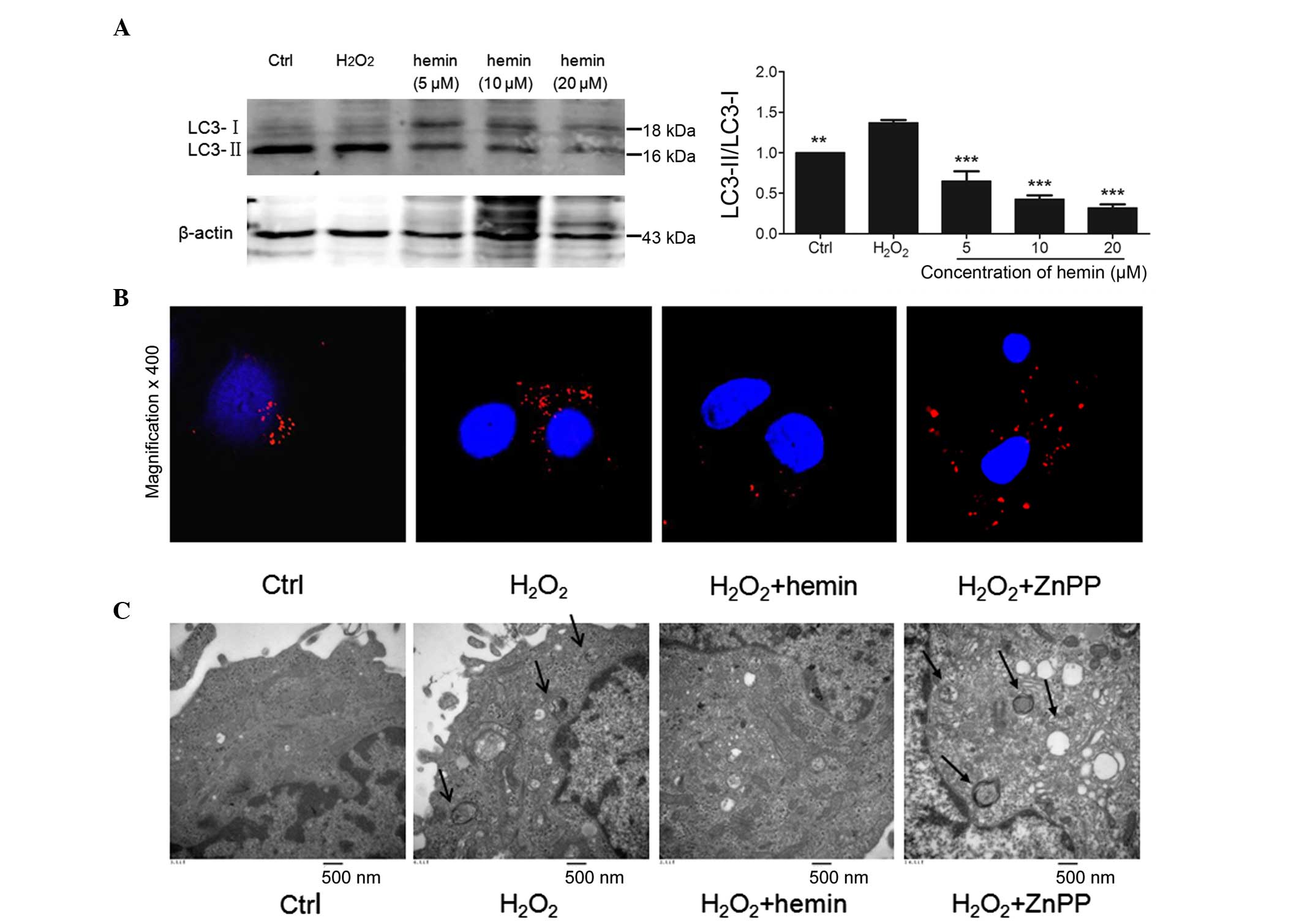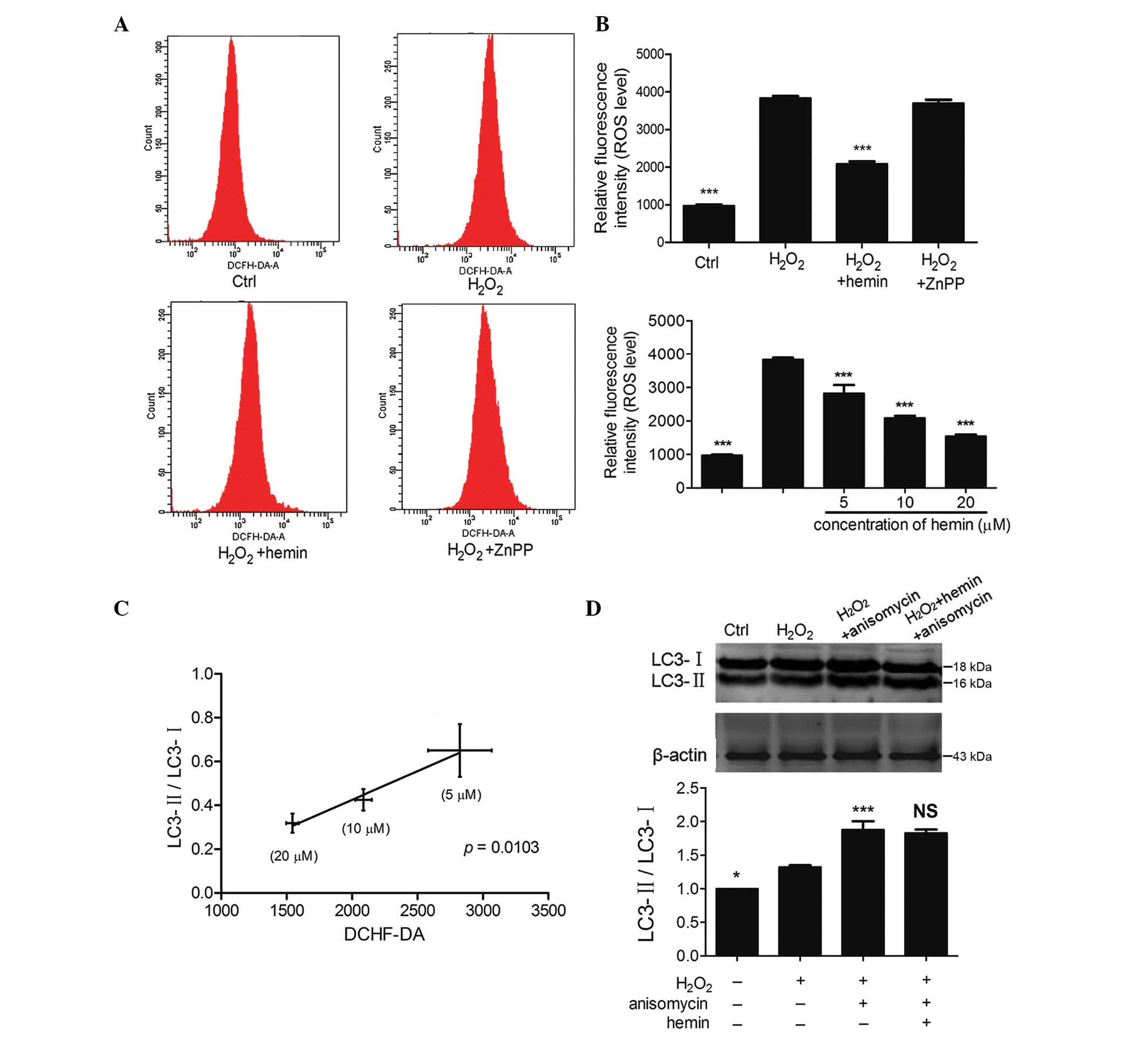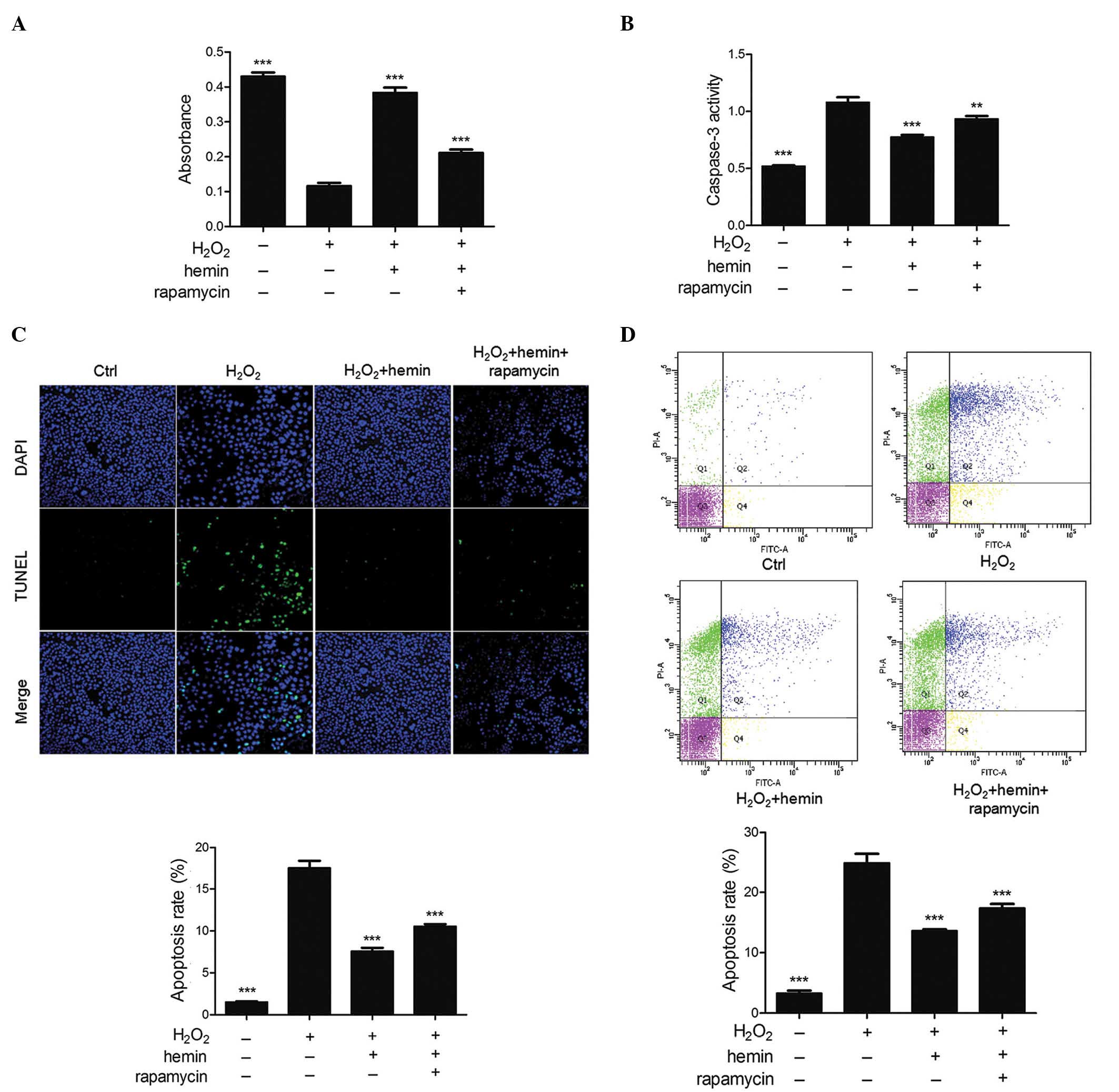|
1
|
Abraham NG, Cao J, Sacerdoti D, Li X and
Drummond G: Heme oxygenase: The key to renal function regulation.
Am J Physiol Renal Physiol. 297:F1137–F1152. 2009. View Article : Google Scholar : PubMed/NCBI
|
|
2
|
Wagner M, Cadetg P, Ruf R, Mazzucchelli L,
Ferrari P and Redaelli CA: Heme oxygenase-1 attenuates
ischemia/reper-fusion-induced apoptosis and improves survival in
rat renal allografts. Kidney Int. 63:1564–1573. 2003. View Article : Google Scholar : PubMed/NCBI
|
|
3
|
Bolisetty S, Traylor AM, Kim J, Joseph R,
Ricart K, Landar A and Agarwal A: Heme oxygenase-1 inhibits renal
tubular macroautophagy in acute kidney injury. J Am Soc Nephrol.
21:1702–712. 2010. View Article : Google Scholar : PubMed/NCBI
|
|
4
|
Castilho Á, Aveleira CA, Leal EC, Simões
NF, Fernandes CR, Meirinhos RI, Baptista FI and Ambrósio AF: Heme
oxygenase-1 protects retinal endothelial cells against high
glucose- and oxidative/nitrosative stress-induced toxicity. PLoS
One. 7:e424282012. View Article : Google Scholar : PubMed/NCBI
|
|
5
|
Zager RA, Johnson AC and Becker K: Plasma
and urinary heme oxygenase-1 in AKI. J Am Soc Nephrol.
23:1048–1057. 2012. View Article : Google Scholar : PubMed/NCBI
|
|
6
|
Gozzelino R, Jeney V and Soares MP:
Mechanisms of cell protection by heme oxygenase-1. Annu Rev
Pharmacol Toxicol. 50:323–354. 2010. View Article : Google Scholar : PubMed/NCBI
|
|
7
|
Kapitsinou PP and Haase VH: HO-1 in
control of a self-eating kidney. J Am Soc Nephrol. 21:1600–1602.
2010. View Article : Google Scholar : PubMed/NCBI
|
|
8
|
Klionsky DJ: Autophagy: From phenomenology
to molecular understanding in less than a decade. Nat Rev Mol Cell
Biol. 8:931–937. 2007. View
Article : Google Scholar : PubMed/NCBI
|
|
9
|
Choi AM, Ryter SW and Levine B: Autophagy
in human health and disease. N Engl J Med. 368:651–662. 2013.
View Article : Google Scholar : PubMed/NCBI
|
|
10
|
Shintani T and Klionsky DJ: Autophagy in
health and disease: A double-edged sword. Science. 306:990–995.
2004. View Article : Google Scholar : PubMed/NCBI
|
|
11
|
Mizushima N, Levine B, Cuervo AM and
Klionsky DJ: Autophagy fights disease through cellular
self-digestion. Nature. 451:1069–1075. 2008. View Article : Google Scholar : PubMed/NCBI
|
|
12
|
Mizushima N and Komatsu M: Autophagy:
Renovation of cells and tissues. Cell. 147:728–741. 2011.
View Article : Google Scholar : PubMed/NCBI
|
|
13
|
Wang LT, Chen BL, Wu CT, Huang KH, Chiang
CK and Hwa Liu S: Protective role of AMP-activated protein
kinase-evoked autophagy on an in vitro model of
ischemia/reperfusion-induced renal tubular cell injury. PLoS One.
8:e798142013. View Article : Google Scholar : PubMed/NCBI
|
|
14
|
Lim SW, Hyoung BJ, Piao SG, Doh KC, Chung
BH and Yang CW: Chronic cyclosporine nephropathy is characterized
by excessive autophagosome formation and decreased autophagic
clearance. Transplantation. 94:218–225. 2012. View Article : Google Scholar : PubMed/NCBI
|
|
15
|
Jiang M, Liu K, Luo J and Dong Z:
Autophagy is a renoprotective mechanism during in vitro hypoxia and
in vivo ischemia-reperfusion injury. Am J Pathol. 176:1181–1192.
2010. View Article : Google Scholar : PubMed/NCBI
|
|
16
|
Wu H, Wang MC and Bohmann D: JNK protects
Drosophila from oxidative stress by trancriptionally activating
autophagy. Mech Dev. 126:624–37. 2009. View Article : Google Scholar : PubMed/NCBI
|
|
17
|
Haberzettl P and Hill BG: Oxidized lipids
activate autophagy in a JNK-dependent manner by stimulating the
endoplasmic reticulum stress response. Redox Biol. 1:56–64. 2013.
View Article : Google Scholar : PubMed/NCBI
|
|
18
|
Rubio N, Verrax J, Dewaele M, Verfaillie
T, Johansen T, Piette J and Agostinis P: p38(MAPK)-regulated
induction of p62 and NBR1 after photodynamic therapy promotes
autophagic clearance of ubiquitin aggregates and reduces reactive
oxygen species levels by supporting Nrf2-antioxidant signaling.
Free Radic Biol Med. 67:292–303. 2014. View Article : Google Scholar
|
|
19
|
Paccosi S, Musilli C, Mangano G,
Guglielmotti A and Parenti A: The monocyte chemotactic protein
synthesis inhibitor bindarit prevents mesangial cell proliferation
and extracellular matrix remodeling. Pharmacol Res. 66:526–535.
2012. View Article : Google Scholar : PubMed/NCBI
|
|
20
|
Shimizu H, Takahashi T, Suzuki T, Yamasaki
A, Fujiwara T, Odaka Y, Hirakawa M, Fujita H and Akagi R:
Protective effect of heme oxygenase induction in ischemic acute
renal failure. Crit Care Med. 28:809–817. 2000. View Article : Google Scholar
|
|
21
|
Xu J, Meng K, Zhang R, Yang H, Liao C, Zhu
W and Jiao J: The use of functional chemical-protein associations
to identify multi-pathway renoprotectants. PLoS One. 9:e979062014.
View Article : Google Scholar : PubMed/NCBI
|
|
22
|
Stockand JD and Sansom SC: Glomerular
mesangial cells: Electrophysiology and regulation of contraction.
Physiol Rev. 78:723–744. 1998.PubMed/NCBI
|
|
23
|
Jaimes EA, Hua P, Tian RX and Raij L:
Human glomerular endothelium: Interplay among glucose, free fatty
acids, angiotensin II, and oxidative stress. Am J Physiol Renal
Physiol. 298:F125–F132. 2010. View Article : Google Scholar :
|
|
24
|
Takahashi T, Morita K, Akagi R and Sassa
S: Protective role of heme oxygenase-1 in renal ischemia. Antioxid
Redox Signal. 6:867–877. 2004. View Article : Google Scholar : PubMed/NCBI
|
|
25
|
Shi Q, Feng YN, Fang J and Xu K:
Pretreatment with glutamine attenuates anoxia/reoxygenation injury
of human proximal renal tubular epithelial cells via induction of
heme oxygenase-1. Pharmacology. 84:1–8. 2009. View Article : Google Scholar : PubMed/NCBI
|
|
26
|
Ryter SW and Choi AM: Regulation of
autophagy in oxygen-dependent cellular stress. Curr Pharm Des.
19:2747–2756. 2013. View Article : Google Scholar
|
|
27
|
Salahudeen AK, Yang M, Huang H, Dore S and
Stec DE: Fenoldopam preconditioning: Role of heme oxygenase-1 in
protecting human tubular cells and rodent kidneys against
cold-hypoxic injury. Transplantation. 91:176–182. 2011. View Article : Google Scholar :
|
|
28
|
Kiffin R, Bandyopadhyay U and Cuervo AM:
Oxidative stress and autophagy. Antioxid Redox Signal. 8:152–162.
2006. View Article : Google Scholar : PubMed/NCBI
|
|
29
|
Li CW, Lin YF, Liu TT and Wang JY: Heme
oxygenase-1 aggravates heat stress-induced neuronal injury and
decreases autophagy in cerebellar Purkinje cells of rats. Exp Biol
Med (Maywood). 238:744–754. 2013. View Article : Google Scholar
|
|
30
|
Yun N, Cho HI and Lee SM: Impaired
autophagy contributes to hepatocellular damage during
ischemia/reperfusion: Heme oxygenase-1 as a possible regulator.
Free Radic Biol Med. 68:168–177. 2014. View Article : Google Scholar
|
|
31
|
Zhao Y, Zhang L, Qiao Y, Zhou X, Wu G,
Wang L, Peng Y, Dong X, Huang H, Si L, et al: Heme oxygenase-1
prevents cardiac dysfunction in streptozotocin-diabetic mice by
reducing inflammation, oxidative stress, apoptosis and enhancing
autophagy. PLoS One. 8:e759272013. View Article : Google Scholar : PubMed/NCBI
|
|
32
|
Scherz-Shouval R, Shvets E, Fass E, Shorer
H, Gil L and Elazar Z: Reactive oxygen species are essential for
autophagy and specifically regulate the activity of Atg4. EMBO J.
26:1749–1760. 2007. View Article : Google Scholar : PubMed/NCBI
|
|
33
|
Leonarduzzi G, Sottero B, Testa G, Biasi F
and Poli G: New insights into redox-modulated cell signaling. Curr
Pharm Des. 17:3994–4006. 2011. View Article : Google Scholar : PubMed/NCBI
|
|
34
|
Lorin S, Pierron G, Ryan KM, Codogno P and
Djavaheri-Mergny M: Evidence for the interplay between JNK and
p53-DRAM signalling pathways in the regulation of autophagy.
Autophagy. 6:153–154. 2010. View Article : Google Scholar
|
|
35
|
Kietzmann T, Samoylenko A and Immenschuh
S: Transcriptional regulation of heme oxygenase-1 gene expression
by MAP kinases of the JNK and p38 pathways in primary cultures of
rat hepatocytes. J Biol Chem. 278:17927–17936. 2003. View Article : Google Scholar : PubMed/NCBI
|
|
36
|
Thorburn A: Apoptosis and autophagy:
Regulatory connections between two supposedly different processes.
Apoptosis. 13:1–9. 2008. View Article : Google Scholar :
|

















